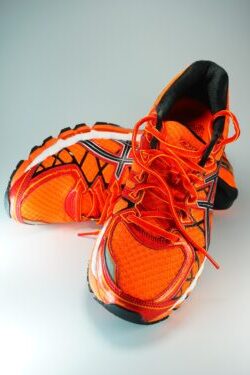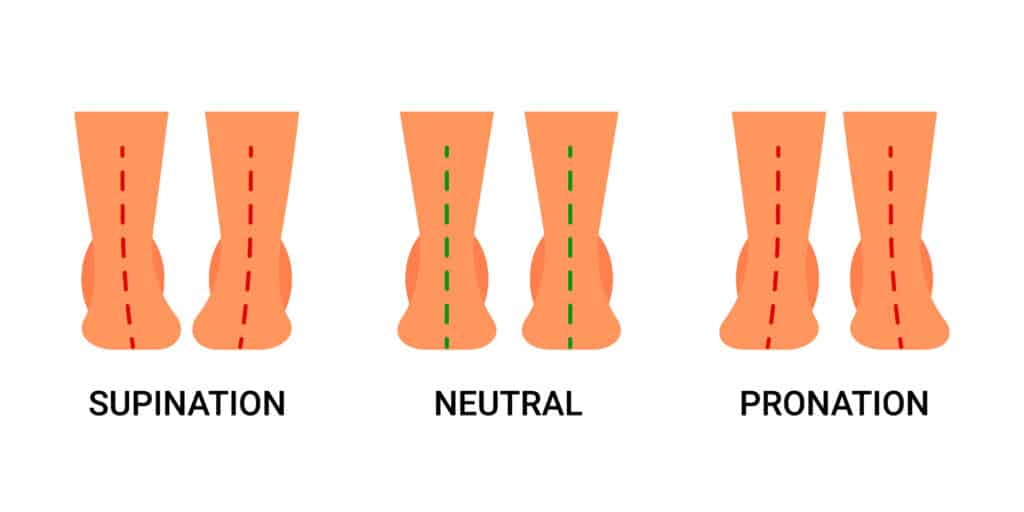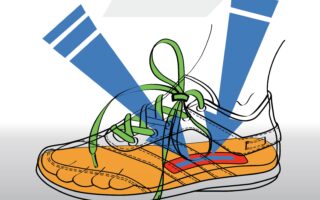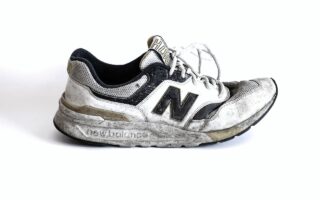As an experienced runner, I am aware of the significance of choosing a proper pair to

achieve peak performance. Drawing upon my experiences in the field of running footwear, this article will explore how shoe design and barefoot running can influence your performance. We’ll dive into barefoot running and why it’s become so popular among competitive runners, as well as discuss minimal shoes and their benefits for participants looking to run faster.
We’ll also examine the concept of heel-to-toe drop and how it impacts your preferred movement path while running. Additionally, we’ll touch on the role that midsole cushioning plays in providing comfort during physical activity. By understanding these factors, you can make an informed decision when choosing a good pair of running shoes that supports your unique needs.
In summary, whether you’re new to running or a seasoned veteran, having a solid understanding of footwear science is essential to achieving peak performance. So let’s get started!
Quick Navigation
Quick Navigation
Benefits of Running Shoes
Running shoes are essential for any runner, whether you’re a new or experienced athlete. They provide support and protection to your feet while running, helping you stay comfortable and injury-free. There are many benefits of wearing running shoes that can help improve your performance on the track or trail.
One major benefit of running shoes is improved cushioning. Running shoes have more cushioning than regular sneakers because they are designed to absorb shock when landing on hard surfaces like pavement or dirt trails. The additional padding in running shoes assists with lessening the strain on one’s body, particularly in areas such as ankles, knees, hips and lower back. The extra cushion also helps protect against injuries caused by repetitive impact from long runs over rough terrain.
Running shoes also offer better stability than regular sneakers because they have thicker soles with increased grip for better traction during runs in wet weather conditions or over slippery surfaces like rocks and roots found on trails. Additionally, some running shoe models feature special technologies such as arch supports that provide additional stability when navigating uneven ground during off-road adventures.
In addition to providing comfort and stability while running, another great benefit of wearing proper footwear is improved performance levels due to less energy being wasted through foot movement within the shoe itself (known as slippage). Shoes with snug fits minimize this slippage so runners don’t waste valuable energy with every stride taken; instead their efforts go directly into propelling them forward faster.
Finally, quality running shoes last longer than other types of athletic footwear thanks to durable materials used in construction which increases value for money spent. This is an important consideration if you are serious about improving your speed times.
Running shoes offer a plethora of advantages that can aid in augmenting running proficiency and ease. With the right pair, you can enjoy improved stability, cushioning, and support while on the run. Now let’s take a look at some of the different types of running shoes available to choose from.
Key Takeaway: Running shoes provide essential cushioning and stability for runners, helping them stay injury-free while also improving performance levels. Footwear that provides greater value for money due to its durability is available in the form of running shoes.
Road Running Shoe Types
Neutral, Motion Control, and Stability. Each type is designed to solve different needs depending on the runner’s style and physical requirements.
Neutral Running Shoes are best for runners who have a normal gait cycle with no overpronation or supination issues. These shoes provide cushioning that absorbs shock while allowing natural movement of the foot. They typically feature a flexible sole and lightweight design that allows for quick movements without sacrificing stability or support.
Motion Control Running Shoes are ideal for runners who have an excessive pronation issue due to their feet rolling inward when they run. These shoes offer more structure than neutral shoes in order to help control the motion of the foot and reduce over-rotation during each stride. They often feature thicker midsoles with firmer materials like EVA foam which provides extra stability and cushioning needed by these types of runners.
Stability Running Shoes are great for those who suffer from mild overpronation but don’t need as much support as someone with an excessive pronation issue would require from a motion control shoe. These shoes offer moderate arch support along with softer cushioning than what is found in motion control models so that you can still enjoy some flexibility while maintaining proper alignment during your runs. The midsole will also usually be made up of multiple layers of material such as EVA foam, polyurethane foam, or air pockets which provide additional shock absorption throughout your stride cycle without sacrificing any responsiveness or speediness you may desire out on the roads.
Regardless of the kind of road running shoe, ensure it fits correctly and provides adequate support for your personal requirements to guarantee optimal comfort during all jogs.
Being mindful of the various kinds of running shoes available is essential in order to make a wise choice when picking out footwear. Choosing the right running shoe can help improve performance, reduce injury risk and provide overall comfort while on your run.
Key Takeaway: Road running shoes come in three types: Neutral, Motion Control and Stability. Each type is designed to meet the individual needs of runners based on their gait cycle and pronation issues, offering cushioning for shock absorption while providing support and stability as well. Select a shoe that fits properly to ensure optimal comfort during your runs.
Choosing the Right Running Shoe
Selecting the optimal running shoe is critical for all runners, from experienced racers to occasional joggers. For an optimal fit, take into account your running technique, shoe structure and qualities, as well as how comfy they feel.
First off, think about how you run. Do you prefer a heel-to-toe drop or minimal shoes? Are you a participant in competitive races or do you just like to run for fun? Knowing your preferred movement path will help narrow down which type of shoe is best suited for your needs.
Next up is looking at the design of the shoe itself. Look at what kind of midsole cushioning it offers and if it has arch support built into its construction. Many brands now offer extra stability options that can help reduce pronation while still allowing flexibility in other areas so that runners can move intuitively without feeling restricted by their footwear choice.
Finally, try on different pairs before making a purchase decision. It’s important to get a feel for how comfortable each pair is before committing to one as no two feet are alike and what works well for one person may not be ideal for another’s physical activity needs. When trying them on, pay attention to how they fit around the heel area as this should provide an indication of whether or not they’ll stay secure during runs and give enough space around toes so that they don’t rub against fabric when walking or running long distances .
In conclusion, choosing the right running shoes requires some research but with proper guidance it doesn’t have to be overwhelming. Consider your personal preferences such as running style and foot shape then compare different models until finding one that provides both comfortability and performance capabilities; only then will runners be able to achieve their desired results with every stride taken.
Selecting the correct running shoe is essential for optimal comfort and performance, so it’s wise to take your time in making a decision. The next heading will discuss cushioning in running shoes, which plays an integral role in providing shock absorption while you run.
Key Takeaway: To find the perfect running shoe, consider your preferred movement path, evaluate design features such as cushioning and arch support, and try on different pairs for comfortability. Doing so will ensure you pick a pair that both fits well and meets performance expectations – no matter how far or fast you run.
Cushioning in Running Shoes
For runners, cushioning is essential in running shoes as it absorbs the shock of each stride and helps reduce fatigue and strain on the body, allowing for comfortable runs over long distances or uneven terrain. Cushioning helps absorb the impact of your feet against the ground and reduces fatigue and stress on your body. It also provides comfort when running long distances or over rough terrain.
The cushioning for running shoes can vary based on the purpose of the shoe; from having minimal padding in racing flats to more protective cushioning for trail-running. For instance, racing flats are designed with minimal cushioning for maximum speed while trail-running shoes have more cushioning to provide better protection from uneven surfaces. The amount of cushioning can also vary depending on whether you’re a heel striker or forefoot runner; heavier runners may require more cushioning than lighter ones due to their increased impact forces.
In terms of materials, EVA foam is often used as a lightweight and flexible material that offers excellent shock absorption without sacrificing flexibility or breathability. PU foam (polyurethane) is another popular option because it has higher durability than EVA foam but still provides good shock absorption capabilities and support underfoot. Airbags are also becoming increasingly popular in high-end running shoes because they offer superior levels of comfort by using air pockets that compress upon contact with the ground to provide an extra layer of softness and protection from hard surfaces like asphalt roads or rocky trails.
When selecting a running shoe, it is essential to consider the cushioning capacity of the footwear, as this can provide relief from impact and comfort. Moving on from cushioning, supportive features such as arch support are also essential components of a good running shoe.
Key Takeaway: Running shoes should be chosen based on the type of running and runner. Cushioning, materials like EVA foam or PU foam, as well as airbags are all factors to consider for optimal performance and comfort. For optimal performance and comfort, it is advisable to select a running shoe that offers the best cushioning and protection from hard surfaces.
Supportive Features in Running Shoes
The right support can make all the difference when it comes to performance and comfort while running. There are several types of supportive features found in modern running shoes that help keep your feet comfortable and safe during a run.
One of the most important supportive features is cushioning. Cushioning helps absorb shock from impact with the ground, providing more stability for your feet as you run. Modern running shoes commonly incorporate cushioning, like foam or air pockets, to reduce the pressure on feet and safeguard against potential injuries.

Another important feature is arch support. This provides additional support to the arch of your foot which helps distribute weight evenly across your entire foot as you run, reducing strain on specific areas like heels or toes. Some shoes also offer heel counters which provide additional stability by helping to keep your heel in place while you move around quickly or jump up and down during a workout session.
Motion control technology is a key feature found in many running shoes, allowing for improved alignment between the upper and sole unit when transitioning from one movement pattern to another while running. This helps combat over-pronation, which can lead to pain due to poor posture or technique during exercise sessions. By providing better support and stability, motion control technology ensures that your feet are protected against injury as you run.
Finally, breathability is often overlooked but still very important when choosing a pair of good quality runners. Breathable fabrics allow air flow through them so sweat does not build up inside, preventing bacteria growth within the shoe itself and keeping feet dryer for longer periods of time without unpleasant odors caused by trapped moisture inside footwear materials.
Running shoes with supportive features can provide the extra cushioning and stability needed for a comfortable running experience. However, it is also important to consider how durable these shoes are when making your purchase decision; this will be discussed in the next heading.
Key Takeaway: Running shoes should provide cushioning, arch support, motion control technology and breathability to ensure a comfortable and safe running experience. These features help absorb shock from impact with the ground while providing extra stability for your feet as you run, preventing injury and keeping them dryer for longer periods of time without unpleasant odors.
Durability of Running Shoes
A proper pair of running shoes is an indispensable item for any runner, providing cushioning and support while protecting feet from the strain of hard surfaces; their durability being a key factor in how long they will last. Not only do they provide cushioning and support, but they also help  protect your feet from the rigors of running on hard surfaces. The durability of a running shoe is one of its most important features as it determines how long you can get out of them before needing to replace them.
protect your feet from the rigors of running on hard surfaces. The durability of a running shoe is one of its most important features as it determines how long you can get out of them before needing to replace them.
When selecting a running shoe, durability is an important factor to consider in order to ensure long-term use. For optimal durability, choose running shoes crafted with synthetic materials as they offer superior breathability and flexibility compared to leather or canvas. Synthetic materials used in shoe construction often provide more longevity than leather or canvas due to their enhanced breathability and resilience over time. Additionally, look for shoes that feature reinforced toe boxes and heels as these areas take more wear-and-tear during runs and need extra protection against wear-out over time.
The tread pattern on your running shoes is another factor when looking at durability. A good quality tread pattern helps ensure grip on various surfaces while reducing wear-and-tear caused by sliding or skidding movements while running which can lead to premature breakdowns in some cases if not addressed properly ahead of time. Look for patterns that have deep grooves and lugs designed specifically for different types terrain such as road, trail or track so you know you’re getting optimal performance from your footwear regardless of where you run.
Thicker soles often equate to longer-lasting shoes, though many people opt for thinner ones as they provide better ground feel and feedback on what’s happening beneath the feet – a plus for competitive racers who want every advantage. With increased shock absorption from thicker soles, runners can go further without feeling fatigued quickly due to pounding hard surfaces too frequently, which can lead to serious injury if not taken into account.
Finally, make sure that whatever pair you choose fits well – nothing affects longevity like having ill fitting footwear since improper fit leads to excessive rubbing against skin causing blisters and irritation which then reduces lifespan significantly. Therefore, try on multiple pairs until you find ones with just enough room without being too loose or tight around all parts including toes, heels, ankles etc., for maximum comfort and performance potential.
A runner’s success is highly dependent on the quality and durability of their running shoes. With proper care and maintenance, you can ensure that your running shoes last longer and perform better for many miles to come.
Key Takeaway: Shoes for runners are a must-have, and their robustness is determined by multiple elements such as fabric employed in making them, sole design and thickness. It’s important to find a pair that fits well too; otherwise you may be rubbing yourself raw with ill-fitting footwear.
Care and Maintenance for Running Shoes
In order to maximize the life and performance of your running shoes, proper care is essential. Here are some tips on how to maintain them:
Clean:
Wipe off dirt and mud after every run with a damp cloth or brush. Make sure you clean the soles, laces, tongue, midsole, upper mesh material and toe box thoroughly. For tougher stains use a mild detergent solution or shoe cleaner spray. Let the shoes air dry naturally before storing them away.
Store your running shoes in a cool, dry place when not in use to prevent damage from direct sunlight or heat sources and prolonged wetness. Avoid keeping them near direct sunlight or heat sources as this can cause damage to the materials over time. Additionally, try to keep them away from humid or damp spots for long periods of time as this can hasten deterioration.
Rotate Shoes:

Rotating between two pairs of running shoes helps extend their lifespan by giving each pair enough rest between uses so that they don’t become worn down too quickly from continuous use without any breaks in-between runs. This will help keep both pairs performing optimally forlonger periods of time while still getting maximum mileage out of each pair individually due to having alternate options available when one pair needs more rest than usual after particularly intense workouts/runs etcetera
Key Takeaway: Preserving running shoes is critical to guarantee they endure and perform optimally on the track; this can be done by wiping away debris and mud after each jog, keeping them in a cool, dry area when not utilized, and alternating between two pairs of footwear so that neither pair gets excessively used.
Conclusion
Running shoes are an essential part of any runner’s kit, whether you’re a beginner or experienced. To make an informed choice of running shoes, it is important to understand the features that differentiate them from other types of footwear and how to maintain them for optimal performance. Remember to consider cushioning, support features and durability when making your selection as well as taking care to maintain them properly so they last longer. Invest in quality running shoes that will help keep you safe on every run.
Discover the best running shoes for your needs and unlock your full potential with The Runners Base. Get started today to maximize performance and comfort on every run!

